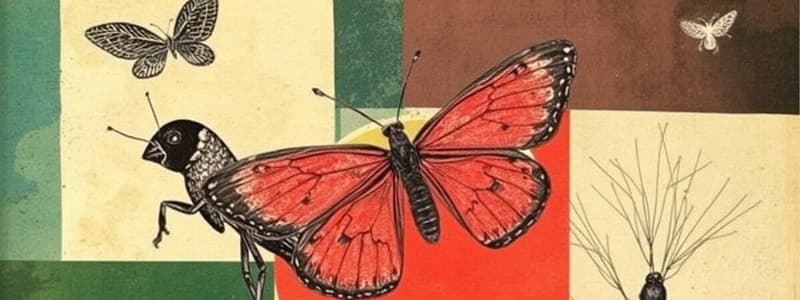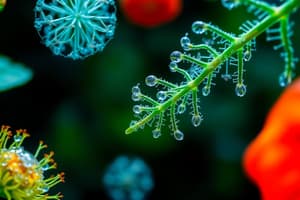Podcast
Questions and Answers
What is the study of the size, composition, and distribution of populations called?
What is the study of the size, composition, and distribution of populations called?
- Population Dynamics (correct)
- Physiology
- Ecology
- Biostatistics
Which of the following best describes density-independent limiting factors?
Which of the following best describes density-independent limiting factors?
- Factors dependent on age distribution in populations
- Factors related to birth rates only
- Factors affecting the population regardless of its size (correct)
- Factors that only impact large populations
Which of the following is an example of a density-dependent factor?
Which of the following is an example of a density-dependent factor?
- Pollution
- Severe weather events
- Wildfires
- Food availability (correct)
What is the correct definition of emigration?
What is the correct definition of emigration?
What does age distribution in a population indicate?
What does age distribution in a population indicate?
What is the growth rate of the world population projected to be in 2024?
What is the growth rate of the world population projected to be in 2024?
Which of the following is NOT a component of population dynamics?
Which of the following is NOT a component of population dynamics?
Which country is projected to surpass China in population in 2024?
Which country is projected to surpass China in population in 2024?
What characteristics distinguish asexual reproduction from sexual reproduction?
What characteristics distinguish asexual reproduction from sexual reproduction?
Which feature is fundamental in distinguishing living organisms from non-living entities?
Which feature is fundamental in distinguishing living organisms from non-living entities?
Which of these processes is associated with homeostasis?
Which of these processes is associated with homeostasis?
What is the role of mitochondria in living organisms?
What is the role of mitochondria in living organisms?
What is unique about the reproduction process in viruses?
What is unique about the reproduction process in viruses?
Which statement best describes evolution and adaptation?
Which statement best describes evolution and adaptation?
Which characteristic of life is primarily responsible for genetic traits passed from parents to offspring?
Which characteristic of life is primarily responsible for genetic traits passed from parents to offspring?
What is phototropism?
What is phototropism?
What characterizes logistic growth compared to exponential growth?
What characterizes logistic growth compared to exponential growth?
Which of the following is not a limiting factor that determines carrying capacity?
Which of the following is not a limiting factor that determines carrying capacity?
In which of the following environments would R-strategies most likely be found?
In which of the following environments would R-strategies most likely be found?
Which reproductive strategy involves organisms that produce fewer offspring over a longer lifespan?
Which reproductive strategy involves organisms that produce fewer offspring over a longer lifespan?
What is the primary reason for clumped population distribution?
What is the primary reason for clumped population distribution?
Which demographic trend is illustrated by the population of the Philippines as of May 1, 2020?
Which demographic trend is illustrated by the population of the Philippines as of May 1, 2020?
What type of population distribution is characterized by limited supplies and competition?
What type of population distribution is characterized by limited supplies and competition?
Which of the following factors does not include components determining Philippine demographic trends?
Which of the following factors does not include components determining Philippine demographic trends?
What is species richness?
What is species richness?
Which of the following describes invasive species?
Which of the following describes invasive species?
What is a characteristic property of water that allows it to remain intact until its surface tension is broken?
What is a characteristic property of water that allows it to remain intact until its surface tension is broken?
Why is genetic diversity important for populations?
Why is genetic diversity important for populations?
Which statement accurately describes water's structure?
Which statement accurately describes water's structure?
What property of water allows it to move through narrow spaces, such as a capillary tube?
What property of water allows it to move through narrow spaces, such as a capillary tube?
Which monomer is associated with carbohydrates?
Which monomer is associated with carbohydrates?
What is the primary role of nucleic acids in living organisms?
What is the primary role of nucleic acids in living organisms?
What type of macromolecule is characterized by being hydrophobic and primarily found in fats and oils?
What type of macromolecule is characterized by being hydrophobic and primarily found in fats and oils?
Which polysaccharide is found in the cell walls of plants?
Which polysaccharide is found in the cell walls of plants?
What term describes the process by which two monosaccharides bond together?
What term describes the process by which two monosaccharides bond together?
What is the monomer of proteins?
What is the monomer of proteins?
Which of the following correctly describes a function of proteins in the body?
Which of the following correctly describes a function of proteins in the body?
Flashcards are hidden until you start studying
Study Notes
Characteristics of Life
- Living organisms exhibit eight key characteristics: Order, Response to Stimuli, Reproduction, Heredity, Growth and Development, Energy Processing, Evolution and Adaptation, Homeostasis.
- Order refers to organized structures, such as unicellular prokaryotes (e.g., bacteria) and multicellular eukaryotes (e.g., whales).
- Response to Stimuli involves reactions to environmental factors, classified as external or internal stimuli.
- Reproduction encompasses the creation of offspring through asexual (one parent, identical offspring) or sexual (two parents, unique offspring) means.
- Heredity is the transmission of genetic material (DNA) from parents to offspring.
- Growth and Development signify that all living things grow and age.
- Energy Processing refers to the use of energy, primarily sourced from ATP produced in mitochondria.
- Homeostasis is the ability to maintain stable internal conditions in response to external changes.
- Evolution and Adaptation allow living beings to change to survive in varying environments.
Responses to Stimuli
- Phototropism refers to the plant's response to light.
- Gravitropism indicates how organisms respond to gravity.
- Regeneration is the process through which organisms heal and regrow lost parts.
- Metamorphosis describes significant physical changes in an organism.
- The axolotl exemplifies adaptation with its ability to regenerate limbs, gills, and lungs quickly.
Population Dynamics
- A population consists of organisms of the same species, influenced by birth, immigration (increase), death, and emigration (decrease).
- Population Dynamics studies the changes in population size, composition, and distribution over time.
- Key components include size (total number of individuals), density (population relative to space), growth (change in size over time), and distribution (spatial arrangement).
- The world population reached 8 billion in 2022, with India predicted to surpass China in population by 2024.
- Population density highlights extremes with Monaco (25,927) and Macao (22,508) having the highest, while lower densities occur in places like CAR.
Limiting Factors and Carrying Capacity
- Limiting factors restrict population growth and are categorized as density-independent (abiotic factors like natural disasters) or density-dependent (biotic factors like competition).
- Carrying Capacity (K) is the maximum number of individuals an environment can sustain, influenced by resources and ecological factors.
- Exponential growth occurs rapidly under abundant resources, while logistic growth decelerates as resources become limited.
Reproductive Strategies
- Reproductive patterns vary; R-strategies (e.g., oysters) focus on high offspring numbers with shorter lifespans, while K-strategies (e.g., chimpanzees) emphasize fewer offspring with longer lifespans.
Biodiversity
- Biodiversity encompasses the variety of life, including genetic, species, and ecosystem diversity.
- Genetic diversity allows populations to adapt to changing environments.
- Species richness refers to the total number of species in an ecosystem, while species abundance measures the relative population of each species.
- Endemic species are native to specific regions (e.g., Philippine Eagle), whereas invasive species can cause harm to native populations (e.g., Midas Cichlid).
Water Properties
- Water covers 70% of the Earth's surface and is critical for processes like digestion, circulation, and thermoregulation.
- Molecularly composed of two hydrogen and one oxygen atom (H2O), it exhibits properties such as high surface tension, heat capacity, and cohesion/adhesion.
Biomolecules
- Four main types of macromolecules are carbohydrates, proteins, lipids, and nucleic acids.
- Carbohydrates are primary energy sources, with monomers called monosaccharides (e.g., glucose).
- Lipids, which include fats and oils, provide long-term energy storage and are hydrophobic.
- Proteins are composed of amino acids, playing roles in structure, function, and regulation within organisms.
- Nucleic acids (DNA and RNA) are responsible for genetic information and directing cellular activities.
Studying That Suits You
Use AI to generate personalized quizzes and flashcards to suit your learning preferences.




